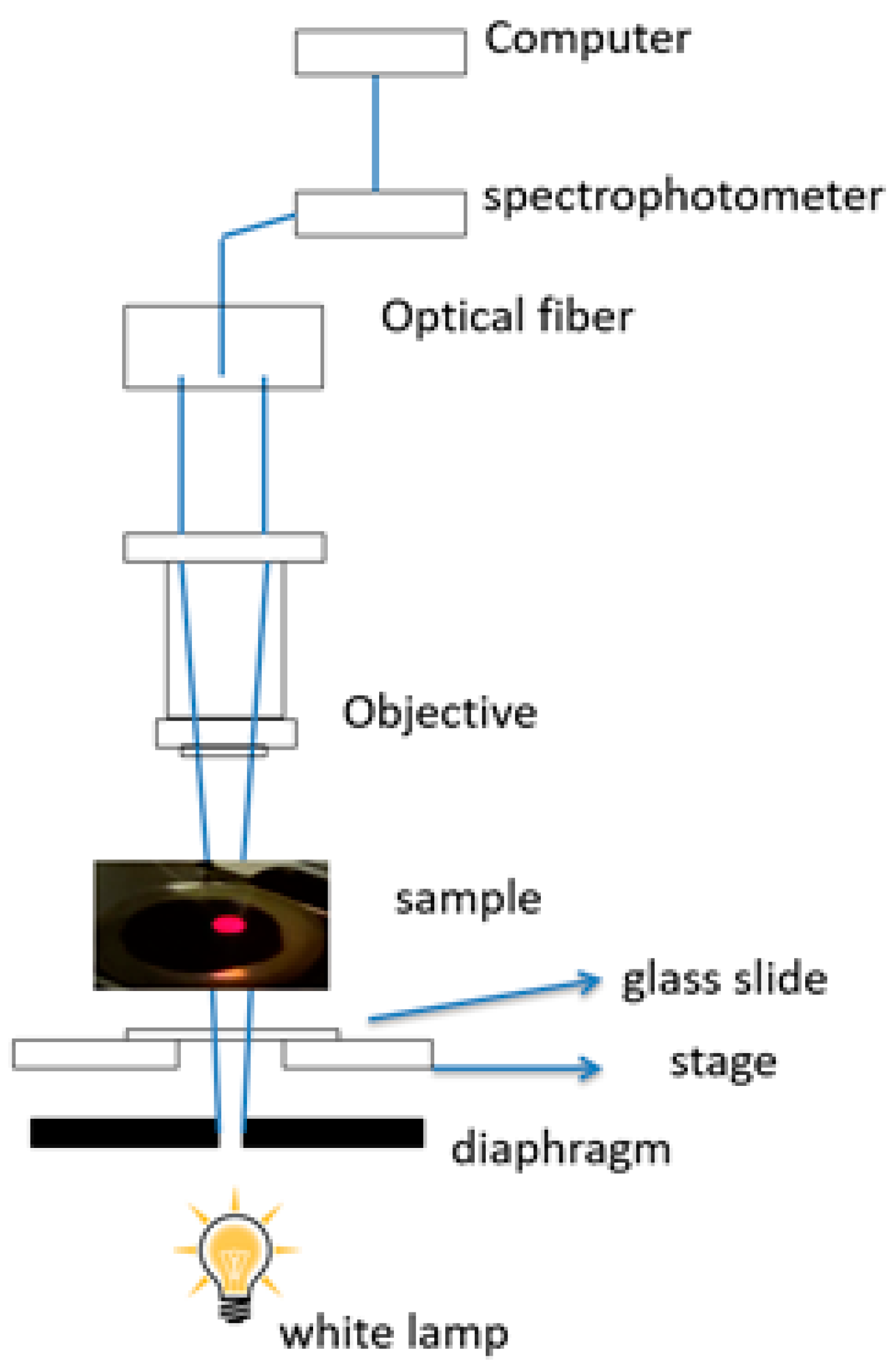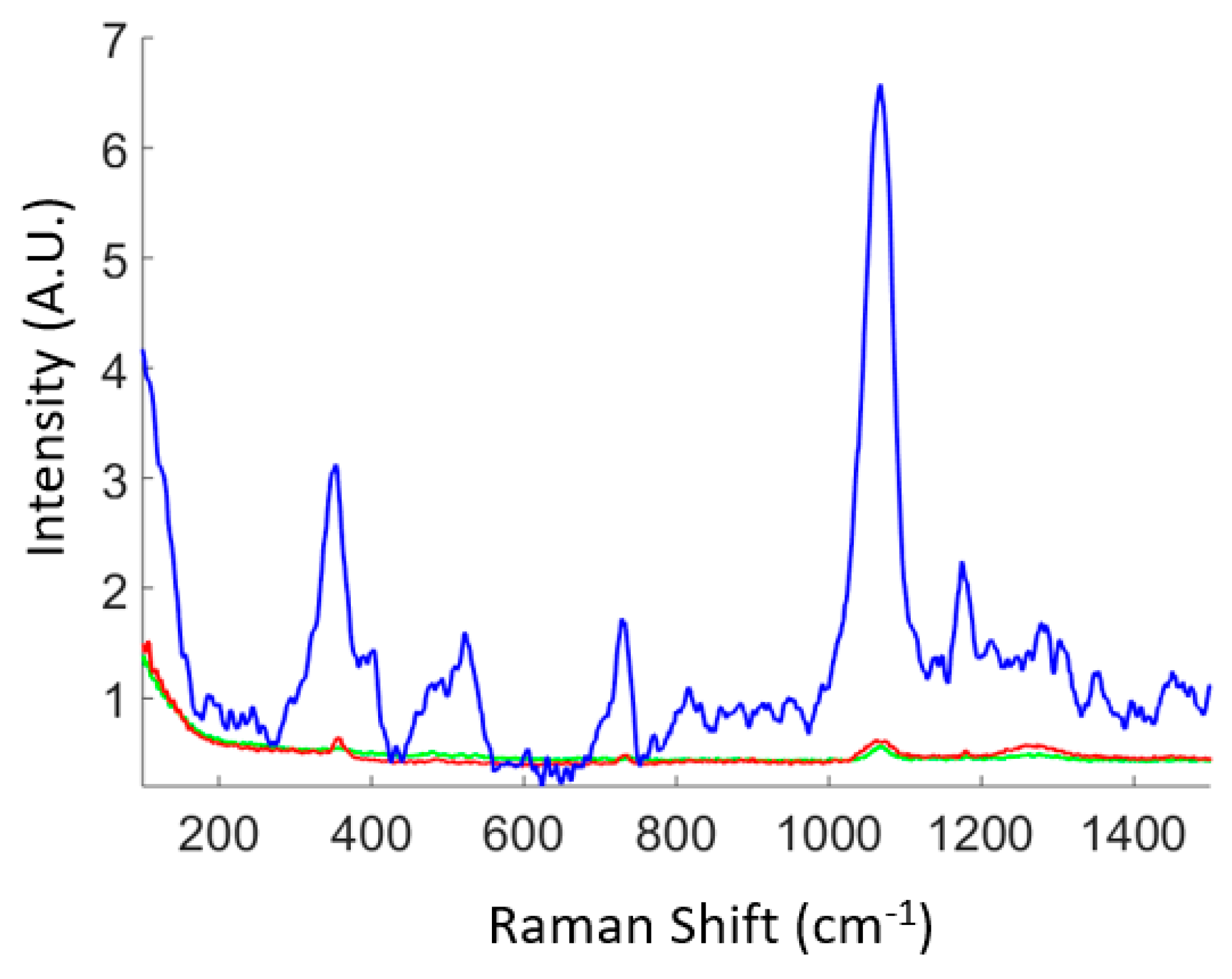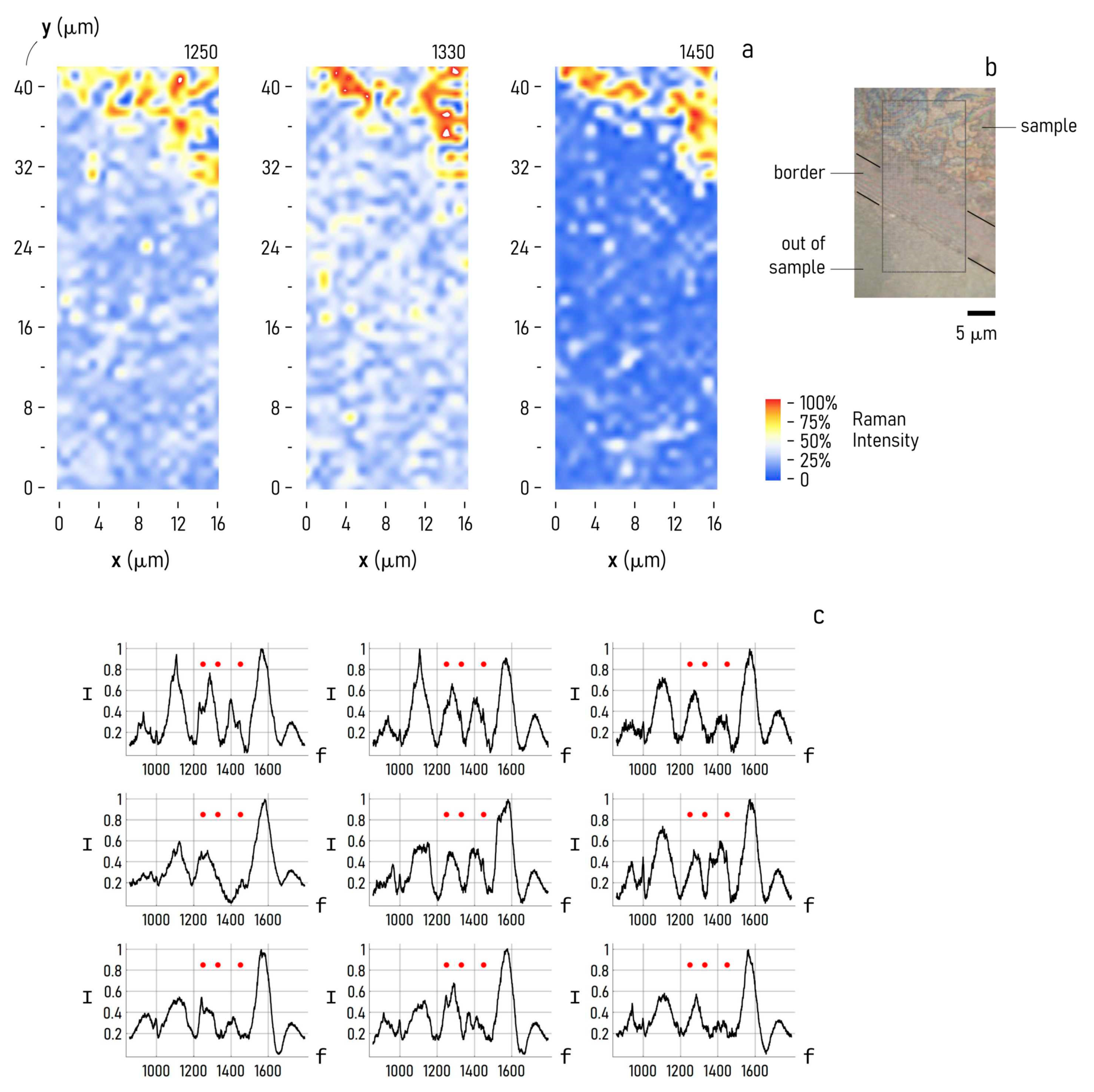Optimization of High-Density Fe-Au Nano-Arrays for Surface-Enhanced Raman Spectroscopy of Biological Samples
Abstract
1. Introduction
2. Materials and Methods
2.1. Nanowires Fabrication
2.2. SEM Analysis
2.3. Light Transmission Measurements
2.4. Raman Spectroscopy
2.5. SERS Analysis of IgG
3. Results—SERS Device
3.1. Characterization of Nanowires
3.2. Detection of Benzenedithiol and IgG Solution Dried on the Biosensor
4. Discussions
5. Conclusions
Supplementary Materials
Author Contributions
Funding
Institutional Review Board Statement
Informed Consent Statement
Data Availability Statement
Acknowledgments
Conflicts of Interest
References
- Gentile, F.; Coluccio, M.L.; Accardo, A.; Marinaro, G.; Rondanina, E.; Santoriello, S.; Marras, S.; Das, G.; Tirinato, L.; Perozziello, G.; et al. Tailored Ag nanoparticles/nanoporous superhydrophobic surfaces hybrid devices for the detection of single molecule. Microelectron. Eng. 2012, 97, 349–352. [Google Scholar] [CrossRef]
- De Angelis, F.; Gentile, F.; Mecarini, F.; Das, G.; Moretti, M.; Candeloro, P.; Coluccio, M.L.; Cojoc, G.; Accardo, A.; Liberale, C.; et al. Breaking the diffusion limit with super-hydrophobic delivery of molecules to plasmonic nanofocusing SERS structures. Nat. Photonics 2011, 5, 682–687. [Google Scholar] [CrossRef]
- Di Fabrizio, E.; Schlücker, S.; Wenger, J.; Regmi, R.; Rigneault, H.; Calafiore, G.; West, M.; Cabrini, S.; Fleischer, M.; Van Hulst, N.F.; et al. Roadmap on biosensing and photonics with advanced nano-optical methods. J. Opt. 2016, 18, 063003. [Google Scholar] [CrossRef]
- Marinaro, G.; Riekel, C.; Gentile, F. Size-exclusion particle separation driven by micro-flows in a quasi-spherical droplet: Modelling and experimental results. Micromachines 2021, 12, 185. [Google Scholar] [CrossRef] [PubMed]
- Laurell, T.; Petersson, F.; Nilsson, A. Chip integrated strategies for acoustic separation and manipulation of cells and particles. Chem. Soc. Rev. 2007, 36, 492–506. [Google Scholar] [CrossRef]
- Shen, Y.; Tolic, N.; Masselon, C.; Pasa-Tolic, L.; Camp, D.G. Nanoscale proteomics. Anal. Bioanal. Chem. 2004, 378, 1037–1045. [Google Scholar] [CrossRef]
- Shen, Y.; Zhao, R.; Berger, S.J.; Anderson, G.A.; Rodriguez, N.; Smith, R.D. High-efficiency nanoscale liquid chromatography coupled on-line with mass spectrometry using nanoelectrospray ionization for proteomics. Anal. Chem. 2002, 74, 4235–4249. [Google Scholar] [CrossRef]
- Marinaro, G.; Das, G.; Giugni, A.; Allione, M.; Torre, B.; Candeloro, P.; Kosel, J.; Di Fabrizio, E. Plasmonic nanowires for wide wavelength range molecular sensing. Materials 2018, 11, 827. [Google Scholar] [CrossRef]
- Mikoliunaite, L.; Rodriguez, R.D.; Sheremet, E.; Kolchuzhin, V.; Mehner, J.; Ramanavicius, A.; Zahn, D.R. The substrate matters in the Raman spectroscopy analysis of cells. Sci. Rep. 2015, 5, 13150. [Google Scholar] [CrossRef]
- Stiles, P.L.; Dieringer, J.A.; Shah, N.C.; Van Duyne, R.P. Surface-enhanced Raman spectroscopy. Annu. Rev. Anal. Chem. 2008, 1, 601–626. [Google Scholar] [CrossRef]
- Camden, J.P.; Dieringer, J.A.; Wang, Y.; Masiello, D.J.; Marks, L.D.; Schatz, G.C.; Van Duyne, R.P. Probing the structure of single-molecule surface-enhanced Raman scattering hot spots. J. Am. Chem. Soc. 2008, 130, 12616–12617. [Google Scholar] [CrossRef]
- Moreno Garcia, J.; Khan, M.A.; Ivanov, Y.P.; Lopatin, S.; Holguin Lerma, J.A.; Marinaro, G.; Ooi, B.S.; Idriss, H.; Kosel, J. Growth of ordered iron oxide nanowires for photo-electrochemical water oxidation. ACS Appl. Energy Mater. 2019, 2, 8473–8480. [Google Scholar] [CrossRef]
- Marinaro, G.; Accardo, A.; De Angelis, F.; Dane, T.; Weinhausen, B.; Burghammer, M.; Riekel, C. A superhydrophobic chip based on SU-8 photoresist pillars suspended on a silicon nitride membrane. Lab. Chip 2014, 14, 3705–3709. [Google Scholar] [CrossRef] [PubMed]
- Marinaro, G.; Accardo, A.; De Angelis, F.; Dane, T.; Weinhausen, B.; Burghammer, M.; Riekel, C. Networks of neuroblastoma cells on porous silicon substrates reveal a small world topology. Integr. Biol. 2015, 7, 184–197. [Google Scholar] [CrossRef] [PubMed]
- Chirumamilla, M.; Das, G.; Toma, A.; Gopalakrishnan, A.; Zaccaria, R.P.; Liberale, C.; De Angelis, F.; Di Fabrizio, E. Optimization and characterization of Au cuboid nanostructures as a SERS device for sensing applications. Microelectron. Eng. 2012, 97, 189–192. [Google Scholar] [CrossRef]
- Das, G.; Patra, N.; Gopalakrishnan, A.; Zaccaria, R.P.; Toma, A.; Thorat, S.; Di Fabrizio, E.; Diaspro, A.; Salerno, M. Fabrication of large-area ordered and reproducible nanostructures for SERS biosensor application. Analyst 2012, 137, 1785–1792. [Google Scholar] [CrossRef]
- Nisticò, R.; Rivolo, F.; Novara, C.; Giorgis, F. New branched flower-like Ag nanostructures for SERS analysis. Colloids Surf. Physicochem. Eng. Asp. 2019, 578, 123600. [Google Scholar] [CrossRef]
- Kattumenu, R.; Lee, C.H.; Tian, L.; McConney, M.E.; Singamaneni, S. Nanorod decorated nanowires as highly efficient SERS-active hybrids. J. Mater. Chem. 2011, 21, 15218–15223. [Google Scholar] [CrossRef]
- Zhang, Y.; Ashall, B.; Doyle, G.; Zerulla, D.; Lee, G.U. Highly ordered fe–au heterostructured nanorod arrays and their exceptional near-infrared plasmonic signature. Langmuir 2012, 28, 17101–17107. [Google Scholar] [CrossRef]
- Mevold, A.H.; Hsu, W.W.; Hardiansyah, A.; Huang, L.Y.; Yang, M.C.; Liu, T.Y.; Chan, T.Y.; Wang, K.S.; Su, Y.A.; Jeng, R.J.; et al. Fabrication of gold nanoparticles/graphene-PDDA nanohybrids for bio-detection by SERS nanotechnology. Nanoscale Res. Lett. 2015, 10, 397. [Google Scholar] [CrossRef]
- Zhang, P.; Yang, S.; Wang, L.; Zhao, J.; Zhu, Z.; Liu, B.; Zhong, J.; Sun, X. Large-scale uniform Au nanodisk arrays fabricated via x-ray interference lithography for reproducible and sensitive SERS substrate. Nanotechnology 2014, 25, 245301. [Google Scholar] [CrossRef]
- Di Mascolo, D.; Coclite, A.; Gentile, F.; Francardi, M. Quantitative micro-Raman analysis of micro-particles in drug delivery. Nanoscale Adv. 2019, 1, 1541–1552. [Google Scholar] [CrossRef] [PubMed]
- Marquart, M.; Deisenhofer, J.; Huber, R.; Palm, W. Crystallographic refinement and atomic models of the intact immunoglobulin molecule Kol and its antigen-binding fragment at 3.0 A and 1.0 A resolution. J Mol. Biol. 1980, 141, 369–391. [Google Scholar] [CrossRef]
- Cai, S.; Singh, B.R. A distinct utility of the amide III infrared band for secondary structure estimation of aqueous protein solutions using partial least squares methods. Biochemistry 2004, 43, 2541–2549. [Google Scholar] [CrossRef] [PubMed]
- Kengne-Momo, R.P.; Daniel, P.; Lagarde, F.; Jeyachandran, Y.L.; Pilard, J.F.; Durand-Thouand, M.J.; Thouand, G. Protein interactions investigated by the Raman spectroscopy for biosensor applications. Int. J. Spectrosc. 2012, 2012, 462901. [Google Scholar] [CrossRef]
- Fischbach, F.T.; Dunning, M.B. A Manual of Laboratory and Diagnostic Tests; Wolters Kluwer Health/Lippincott Williams & Wilkins: Philadelphia, PA, USA, 2009. [Google Scholar]
- Della Ventura, B.; Gelzo, M.; Battista, E.; Alabastri, A.; Schirato, A.; Castaldo, G.; Corso, G.; Gentile, F.; Velotta, R. Biosensor for point-of-care analysis of immunoglobulins in urine by metal enhanced fluorescence from gold nanoparticles. ACS Appl. Mater. Interfaces 2019, 11, 3753–3762. [Google Scholar] [CrossRef] [PubMed]
- Minopoli, A.; Della Ventura, B.; Lenyk, B.; Gentile, F.; Tanner, J.A.; Offenhäusser, A.; Mayer, D.; Velotta, R. RUltrasensitive antibody-aptamer plasmonic biosensor for malaria biomarker detection in whole blood. Nat. Commun. 2020, 11, 6134. [Google Scholar] [CrossRef]







Publisher’s Note: MDPI stays neutral with regard to jurisdictional claims in published maps and institutional affiliations. |
© 2021 by the authors. Licensee MDPI, Basel, Switzerland. This article is an open access article distributed under the terms and conditions of the Creative Commons Attribution (CC BY) license (https://creativecommons.org/licenses/by/4.0/).
Share and Cite
Marinaro, G.; Coluccio, M.L.; Gentile, F. Optimization of High-Density Fe-Au Nano-Arrays for Surface-Enhanced Raman Spectroscopy of Biological Samples. Biosensors 2021, 11, 181. https://doi.org/10.3390/bios11060181
Marinaro G, Coluccio ML, Gentile F. Optimization of High-Density Fe-Au Nano-Arrays for Surface-Enhanced Raman Spectroscopy of Biological Samples. Biosensors. 2021; 11(6):181. https://doi.org/10.3390/bios11060181
Chicago/Turabian StyleMarinaro, Giovanni, Maria Laura Coluccio, and Francesco Gentile. 2021. "Optimization of High-Density Fe-Au Nano-Arrays for Surface-Enhanced Raman Spectroscopy of Biological Samples" Biosensors 11, no. 6: 181. https://doi.org/10.3390/bios11060181
APA StyleMarinaro, G., Coluccio, M. L., & Gentile, F. (2021). Optimization of High-Density Fe-Au Nano-Arrays for Surface-Enhanced Raman Spectroscopy of Biological Samples. Biosensors, 11(6), 181. https://doi.org/10.3390/bios11060181





